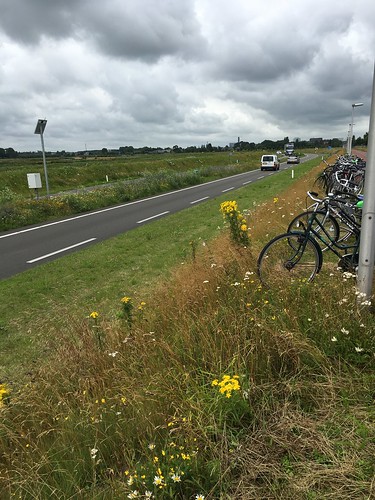Single-lane highways are a unique Dutch design that may appear radical to American drivers. This example, the N470 highway connecting Delft and Pijnacker, has only one lane of travel in each direction, and yet it carries traffic just as well as a much wider American freeway.
Why a single-lane highway? A better question may be: why a multi-lane highway in the first place? From an engineering perspective, the answer is that multiple lanes can carry greater traffic volumes, but for the individual road user, multiple lanes simply provide encouragement to switch lanes, accelerate beyond the speed limit, and pass other drivers. Lane switching is a difficult, dangerous task that requires drivers to maneuver with limited visibility, and it requires a lot of experience and careful judgment to execute. By providing drivers with only one travel lane per direction, single-lane highways prohibit lane switching, greatly simplifying the experience. They also constrain everyone on the road to move at almost the exact same speed, which means that any crashes that may occur will be relatively minor. In addition, at the N470, the lanes are relatively narrow by highway standards: the asphalt is 14 feet wide, the painted lanes are only 10 feet wide, and the two directions of travel are separated by an uncrossable grassy median with bollards. These narrow lanes further discourage speeding and recklessness.
So how do single-lane highways avoid congestion? Conventional engineering wisdom states that one lane of traffic has a maximum capacity of 6,000 to 7,000 vehicles per day in an urban setting. However, this figure takes into account the constraint of frequent stopping and starting at intersections. The N470 highway travels through mostly undeveloped countryside, and traffic is straightforward and uninterrupted, and consequently its capacity is much higher. There is a nearly two-mile stretch of roadway between two roundabouts with no destinations or access points, so it carries through traffic exclusively. The capacity of single-lane highways still has an upper limit, and the conditions that make them effective are not always available. However, if the demand is right and the undeveloped space is available, single-lane highways are a perfect solution to meet the needs of the transportation network while maximizing safety.
An added benefit of the single-lane highway is, of course, it takes up much less space than a multi-lane highway, lowering construction costs and minimizing the disruption to the countryside. The farms and fields that the N470 traverses still retain their rustic beauty; in fact, there are even picnic areas along its length, accessible via the bicycle highway nearby.


